A Comparative Business Environment Analysis of Dyson, BBC, and Shelter
VerifiedAdded on 2022/11/30
|19
|5750
|73
Report
AI Summary
This report provides a comprehensive analysis of the business environment for three distinct organizations: Dyson Ltd, British Broadcasting Corporation (BBC), and Shelter. It begins by explaining different types of organizations, including public, private, and voluntary sectors, and their legal structures. The report then delves into the size and scope of each organization, outlining their backgrounds, products/services, vision, mission, objectives, and organizational structures. It further examines the relationship between different organizational functions and how they link to organizational objectives and structure. The report also identifies the positive and negative impacts of the macro environment on business operations, supported by specific examples, and conducts internal and external analyses to identify strengths and weaknesses. Finally, it applies SWOT/TWOS analysis to justify how they influence decision-making, critically evaluating the impacts of both macro and micro factors on business objectives.
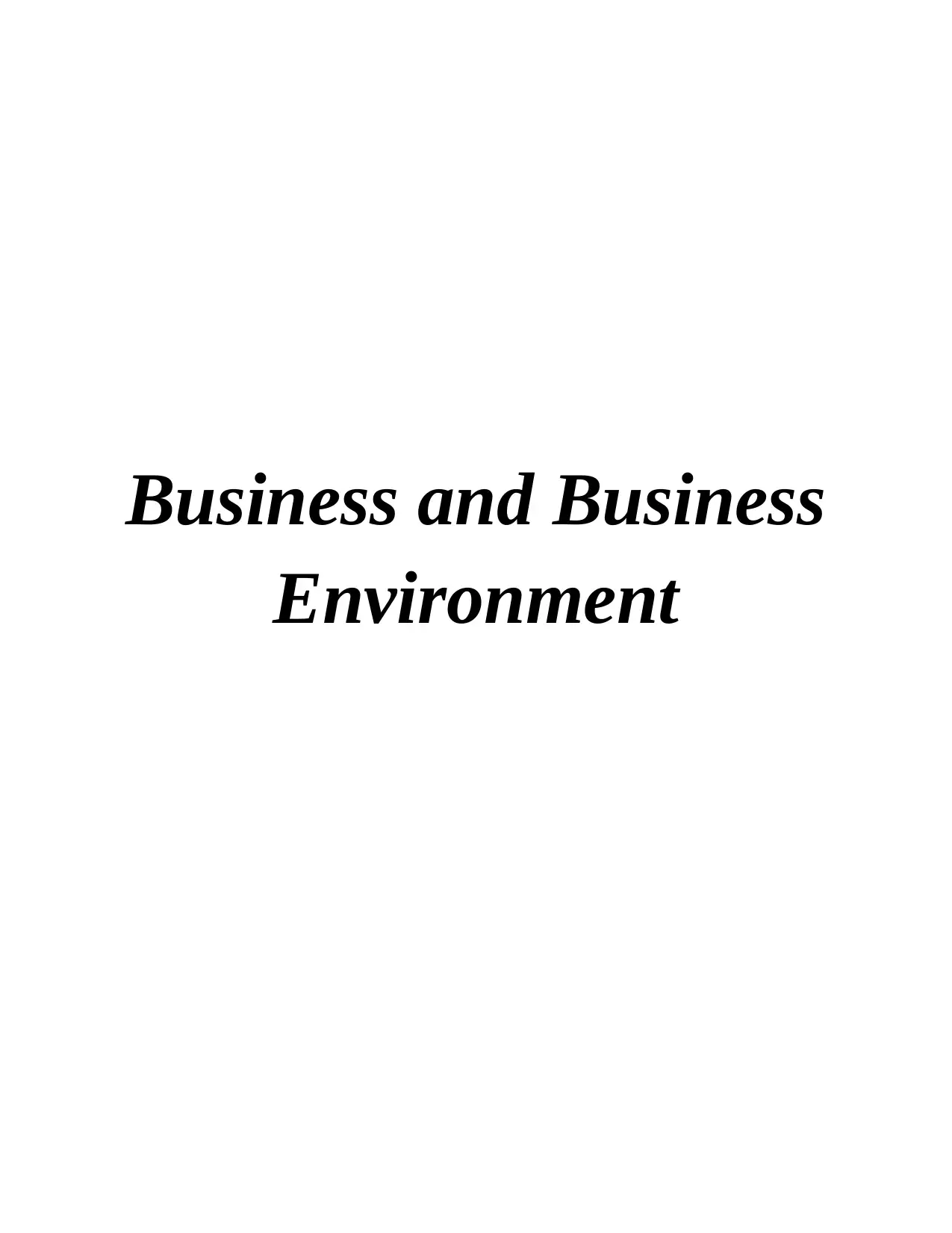
Business and Business
Environment
Environment
Paraphrase This Document
Need a fresh take? Get an instant paraphrase of this document with our AI Paraphraser
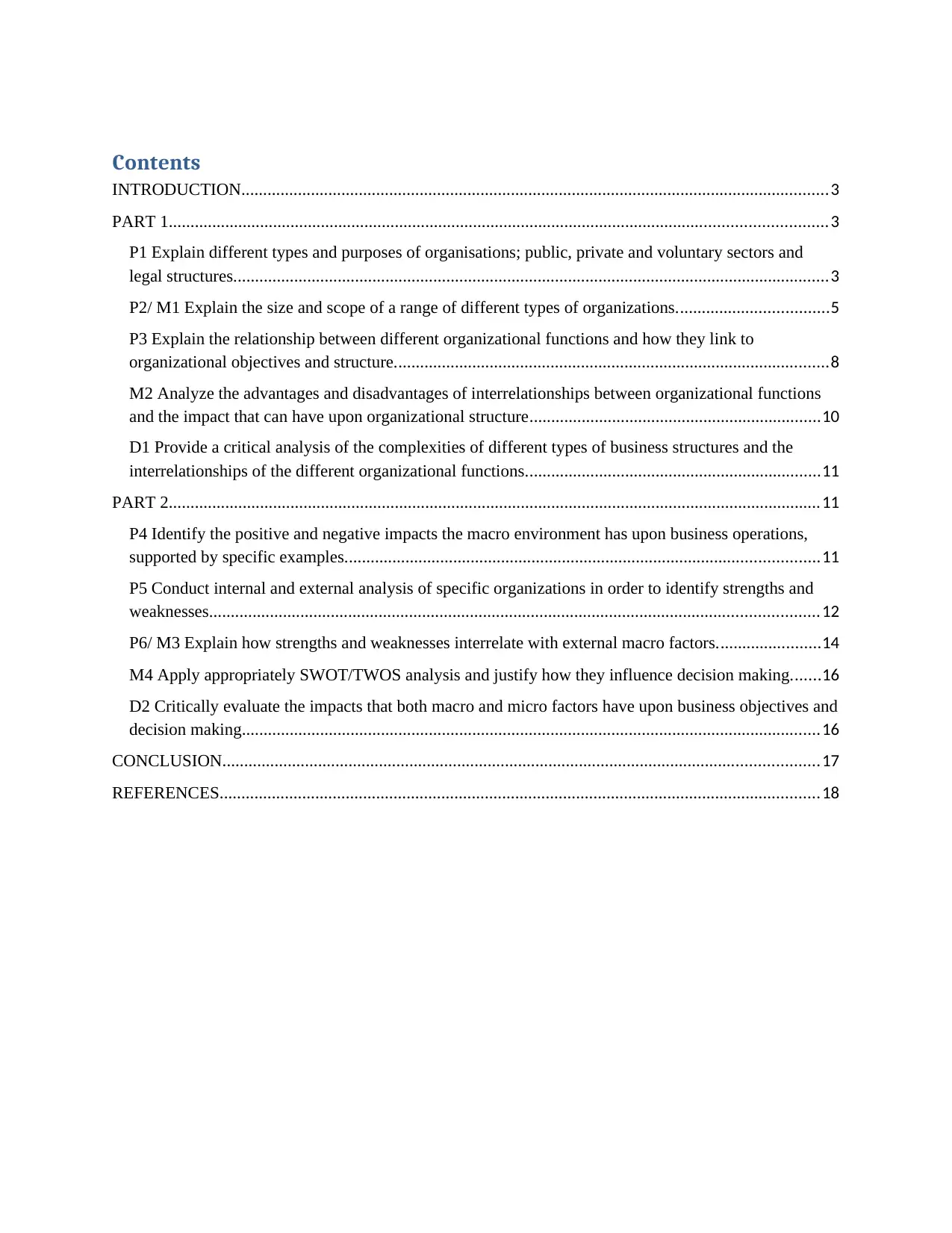
Contents
INTRODUCTION.......................................................................................................................................3
PART 1.......................................................................................................................................................3
P1 Explain different types and purposes of organisations; public, private and voluntary sectors and
legal structures.........................................................................................................................................3
P2/ M1 Explain the size and scope of a range of different types of organizations...................................5
P3 Explain the relationship between different organizational functions and how they link to
organizational objectives and structure....................................................................................................8
M2 Analyze the advantages and disadvantages of interrelationships between organizational functions
and the impact that can have upon organizational structure...................................................................10
D1 Provide a critical analysis of the complexities of different types of business structures and the
interrelationships of the different organizational functions....................................................................11
PART 2......................................................................................................................................................11
P4 Identify the positive and negative impacts the macro environment has upon business operations,
supported by specific examples.............................................................................................................11
P5 Conduct internal and external analysis of specific organizations in order to identify strengths and
weaknesses............................................................................................................................................12
P6/ M3 Explain how strengths and weaknesses interrelate with external macro factors........................14
M4 Apply appropriately SWOT/TWOS analysis and justify how they influence decision making.......16
D2 Critically evaluate the impacts that both macro and micro factors have upon business objectives and
decision making.....................................................................................................................................16
CONCLUSION.........................................................................................................................................17
REFERENCES..........................................................................................................................................18
INTRODUCTION.......................................................................................................................................3
PART 1.......................................................................................................................................................3
P1 Explain different types and purposes of organisations; public, private and voluntary sectors and
legal structures.........................................................................................................................................3
P2/ M1 Explain the size and scope of a range of different types of organizations...................................5
P3 Explain the relationship between different organizational functions and how they link to
organizational objectives and structure....................................................................................................8
M2 Analyze the advantages and disadvantages of interrelationships between organizational functions
and the impact that can have upon organizational structure...................................................................10
D1 Provide a critical analysis of the complexities of different types of business structures and the
interrelationships of the different organizational functions....................................................................11
PART 2......................................................................................................................................................11
P4 Identify the positive and negative impacts the macro environment has upon business operations,
supported by specific examples.............................................................................................................11
P5 Conduct internal and external analysis of specific organizations in order to identify strengths and
weaknesses............................................................................................................................................12
P6/ M3 Explain how strengths and weaknesses interrelate with external macro factors........................14
M4 Apply appropriately SWOT/TWOS analysis and justify how they influence decision making.......16
D2 Critically evaluate the impacts that both macro and micro factors have upon business objectives and
decision making.....................................................................................................................................16
CONCLUSION.........................................................................................................................................17
REFERENCES..........................................................................................................................................18
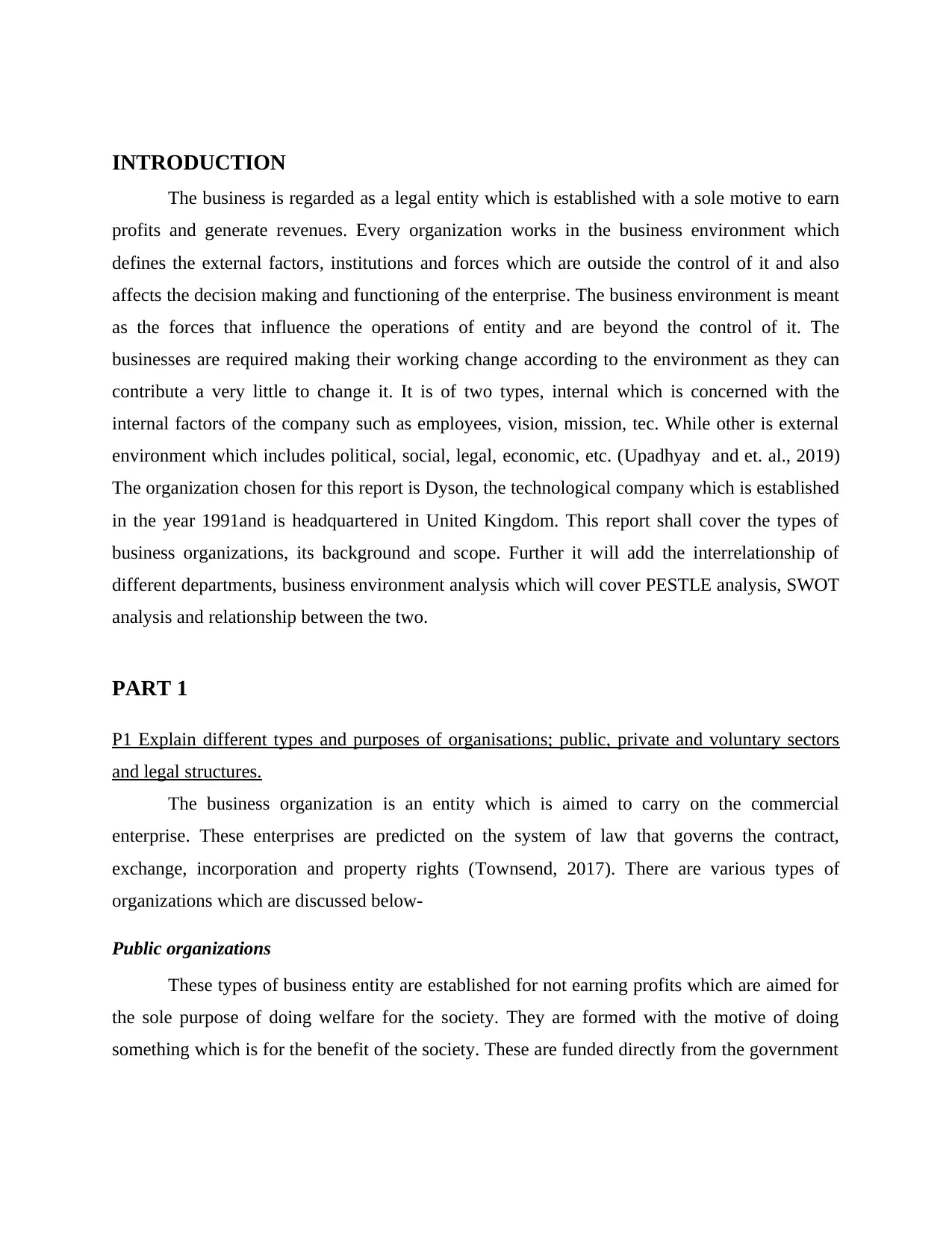
INTRODUCTION
The business is regarded as a legal entity which is established with a sole motive to earn
profits and generate revenues. Every organization works in the business environment which
defines the external factors, institutions and forces which are outside the control of it and also
affects the decision making and functioning of the enterprise. The business environment is meant
as the forces that influence the operations of entity and are beyond the control of it. The
businesses are required making their working change according to the environment as they can
contribute a very little to change it. It is of two types, internal which is concerned with the
internal factors of the company such as employees, vision, mission, tec. While other is external
environment which includes political, social, legal, economic, etc. (Upadhyay and et. al., 2019)
The organization chosen for this report is Dyson, the technological company which is established
in the year 1991and is headquartered in United Kingdom. This report shall cover the types of
business organizations, its background and scope. Further it will add the interrelationship of
different departments, business environment analysis which will cover PESTLE analysis, SWOT
analysis and relationship between the two.
PART 1
P1 Explain different types and purposes of organisations; public, private and voluntary sectors
and legal structures.
The business organization is an entity which is aimed to carry on the commercial
enterprise. These enterprises are predicted on the system of law that governs the contract,
exchange, incorporation and property rights (Townsend, 2017). There are various types of
organizations which are discussed below-
Public organizations
These types of business entity are established for not earning profits which are aimed for
the sole purpose of doing welfare for the society. They are formed with the motive of doing
something which is for the benefit of the society. These are funded directly from the government
The business is regarded as a legal entity which is established with a sole motive to earn
profits and generate revenues. Every organization works in the business environment which
defines the external factors, institutions and forces which are outside the control of it and also
affects the decision making and functioning of the enterprise. The business environment is meant
as the forces that influence the operations of entity and are beyond the control of it. The
businesses are required making their working change according to the environment as they can
contribute a very little to change it. It is of two types, internal which is concerned with the
internal factors of the company such as employees, vision, mission, tec. While other is external
environment which includes political, social, legal, economic, etc. (Upadhyay and et. al., 2019)
The organization chosen for this report is Dyson, the technological company which is established
in the year 1991and is headquartered in United Kingdom. This report shall cover the types of
business organizations, its background and scope. Further it will add the interrelationship of
different departments, business environment analysis which will cover PESTLE analysis, SWOT
analysis and relationship between the two.
PART 1
P1 Explain different types and purposes of organisations; public, private and voluntary sectors
and legal structures.
The business organization is an entity which is aimed to carry on the commercial
enterprise. These enterprises are predicted on the system of law that governs the contract,
exchange, incorporation and property rights (Townsend, 2017). There are various types of
organizations which are discussed below-
Public organizations
These types of business entity are established for not earning profits which are aimed for
the sole purpose of doing welfare for the society. They are formed with the motive of doing
something which is for the benefit of the society. These are funded directly from the government
⊘ This is a preview!⊘
Do you want full access?
Subscribe today to unlock all pages.

Trusted by 1+ million students worldwide
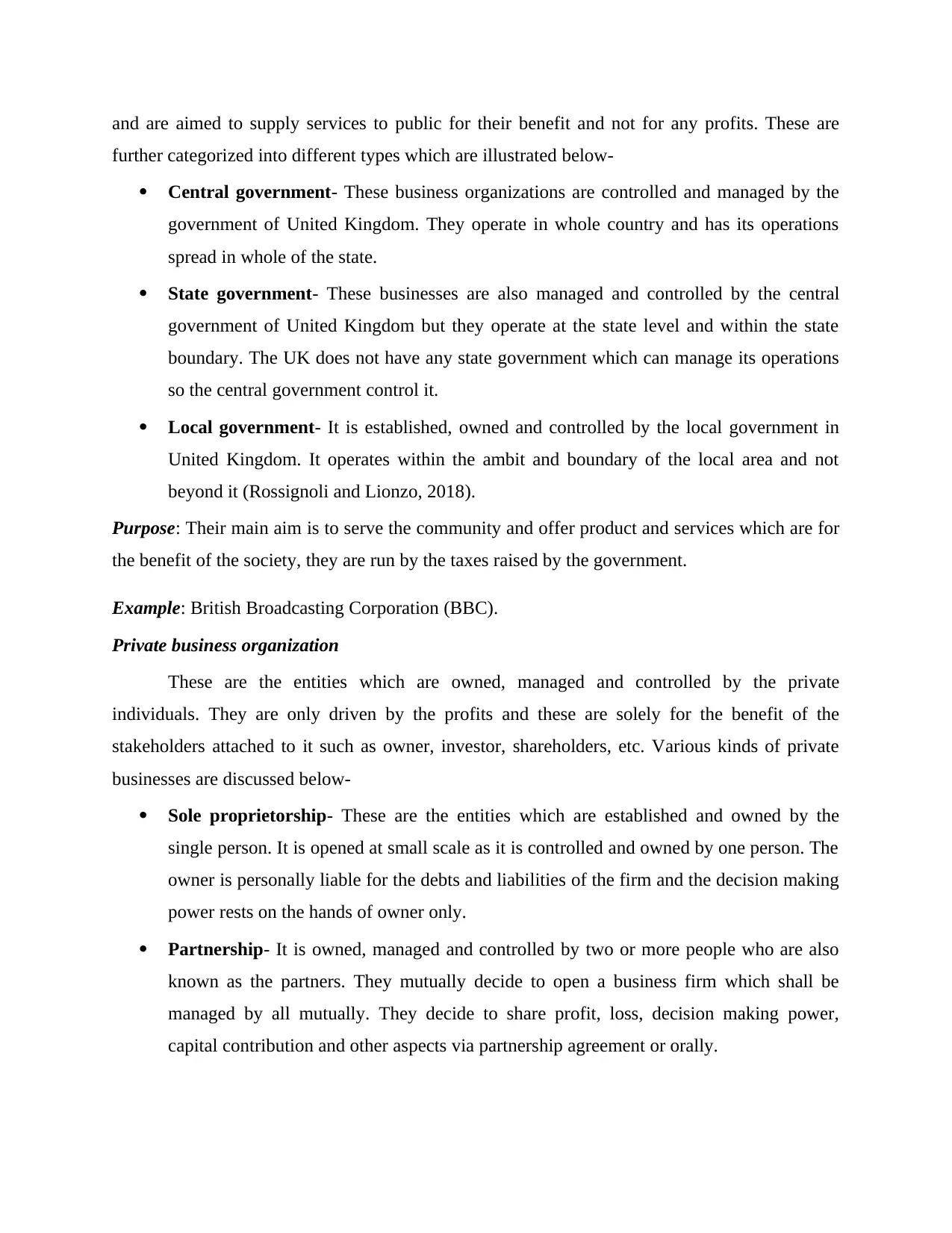
and are aimed to supply services to public for their benefit and not for any profits. These are
further categorized into different types which are illustrated below-
Central government- These business organizations are controlled and managed by the
government of United Kingdom. They operate in whole country and has its operations
spread in whole of the state.
State government- These businesses are also managed and controlled by the central
government of United Kingdom but they operate at the state level and within the state
boundary. The UK does not have any state government which can manage its operations
so the central government control it.
Local government- It is established, owned and controlled by the local government in
United Kingdom. It operates within the ambit and boundary of the local area and not
beyond it (Rossignoli and Lionzo, 2018).
Purpose: Their main aim is to serve the community and offer product and services which are for
the benefit of the society, they are run by the taxes raised by the government.
Example: British Broadcasting Corporation (BBC).
Private business organization
These are the entities which are owned, managed and controlled by the private
individuals. They are only driven by the profits and these are solely for the benefit of the
stakeholders attached to it such as owner, investor, shareholders, etc. Various kinds of private
businesses are discussed below-
Sole proprietorship- These are the entities which are established and owned by the
single person. It is opened at small scale as it is controlled and owned by one person. The
owner is personally liable for the debts and liabilities of the firm and the decision making
power rests on the hands of owner only.
Partnership- It is owned, managed and controlled by two or more people who are also
known as the partners. They mutually decide to open a business firm which shall be
managed by all mutually. They decide to share profit, loss, decision making power,
capital contribution and other aspects via partnership agreement or orally.
further categorized into different types which are illustrated below-
Central government- These business organizations are controlled and managed by the
government of United Kingdom. They operate in whole country and has its operations
spread in whole of the state.
State government- These businesses are also managed and controlled by the central
government of United Kingdom but they operate at the state level and within the state
boundary. The UK does not have any state government which can manage its operations
so the central government control it.
Local government- It is established, owned and controlled by the local government in
United Kingdom. It operates within the ambit and boundary of the local area and not
beyond it (Rossignoli and Lionzo, 2018).
Purpose: Their main aim is to serve the community and offer product and services which are for
the benefit of the society, they are run by the taxes raised by the government.
Example: British Broadcasting Corporation (BBC).
Private business organization
These are the entities which are owned, managed and controlled by the private
individuals. They are only driven by the profits and these are solely for the benefit of the
stakeholders attached to it such as owner, investor, shareholders, etc. Various kinds of private
businesses are discussed below-
Sole proprietorship- These are the entities which are established and owned by the
single person. It is opened at small scale as it is controlled and owned by one person. The
owner is personally liable for the debts and liabilities of the firm and the decision making
power rests on the hands of owner only.
Partnership- It is owned, managed and controlled by two or more people who are also
known as the partners. They mutually decide to open a business firm which shall be
managed by all mutually. They decide to share profit, loss, decision making power,
capital contribution and other aspects via partnership agreement or orally.
Paraphrase This Document
Need a fresh take? Get an instant paraphrase of this document with our AI Paraphraser
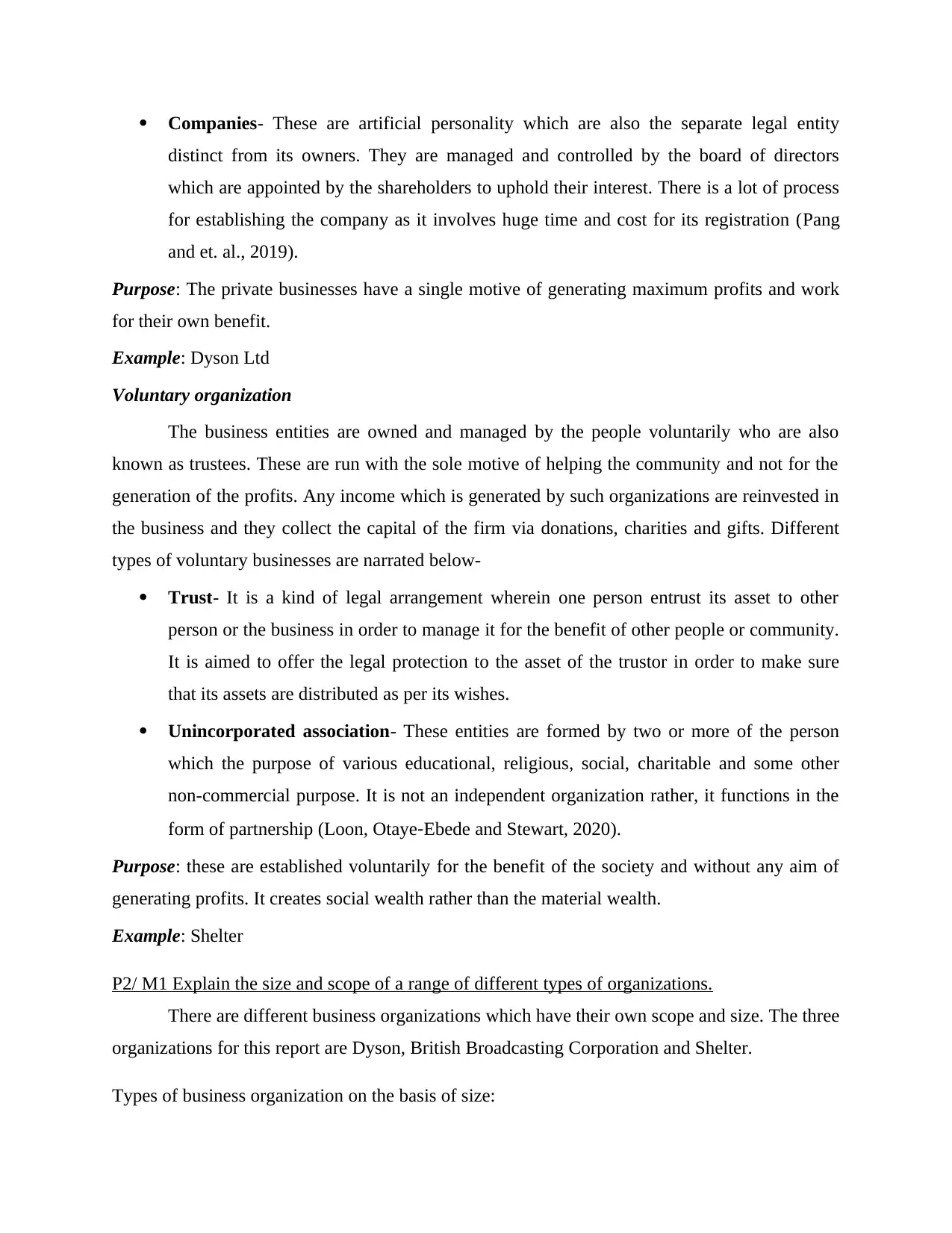
Companies- These are artificial personality which are also the separate legal entity
distinct from its owners. They are managed and controlled by the board of directors
which are appointed by the shareholders to uphold their interest. There is a lot of process
for establishing the company as it involves huge time and cost for its registration (Pang
and et. al., 2019).
Purpose: The private businesses have a single motive of generating maximum profits and work
for their own benefit.
Example: Dyson Ltd
Voluntary organization
The business entities are owned and managed by the people voluntarily who are also
known as trustees. These are run with the sole motive of helping the community and not for the
generation of the profits. Any income which is generated by such organizations are reinvested in
the business and they collect the capital of the firm via donations, charities and gifts. Different
types of voluntary businesses are narrated below-
Trust- It is a kind of legal arrangement wherein one person entrust its asset to other
person or the business in order to manage it for the benefit of other people or community.
It is aimed to offer the legal protection to the asset of the trustor in order to make sure
that its assets are distributed as per its wishes.
Unincorporated association- These entities are formed by two or more of the person
which the purpose of various educational, religious, social, charitable and some other
non-commercial purpose. It is not an independent organization rather, it functions in the
form of partnership (Loon, Otaye‐Ebede and Stewart, 2020).
Purpose: these are established voluntarily for the benefit of the society and without any aim of
generating profits. It creates social wealth rather than the material wealth.
Example: Shelter
P2/ M1 Explain the size and scope of a range of different types of organizations.
There are different business organizations which have their own scope and size. The three
organizations for this report are Dyson, British Broadcasting Corporation and Shelter.
Types of business organization on the basis of size:
distinct from its owners. They are managed and controlled by the board of directors
which are appointed by the shareholders to uphold their interest. There is a lot of process
for establishing the company as it involves huge time and cost for its registration (Pang
and et. al., 2019).
Purpose: The private businesses have a single motive of generating maximum profits and work
for their own benefit.
Example: Dyson Ltd
Voluntary organization
The business entities are owned and managed by the people voluntarily who are also
known as trustees. These are run with the sole motive of helping the community and not for the
generation of the profits. Any income which is generated by such organizations are reinvested in
the business and they collect the capital of the firm via donations, charities and gifts. Different
types of voluntary businesses are narrated below-
Trust- It is a kind of legal arrangement wherein one person entrust its asset to other
person or the business in order to manage it for the benefit of other people or community.
It is aimed to offer the legal protection to the asset of the trustor in order to make sure
that its assets are distributed as per its wishes.
Unincorporated association- These entities are formed by two or more of the person
which the purpose of various educational, religious, social, charitable and some other
non-commercial purpose. It is not an independent organization rather, it functions in the
form of partnership (Loon, Otaye‐Ebede and Stewart, 2020).
Purpose: these are established voluntarily for the benefit of the society and without any aim of
generating profits. It creates social wealth rather than the material wealth.
Example: Shelter
P2/ M1 Explain the size and scope of a range of different types of organizations.
There are different business organizations which have their own scope and size. The three
organizations for this report are Dyson, British Broadcasting Corporation and Shelter.
Types of business organization on the basis of size:
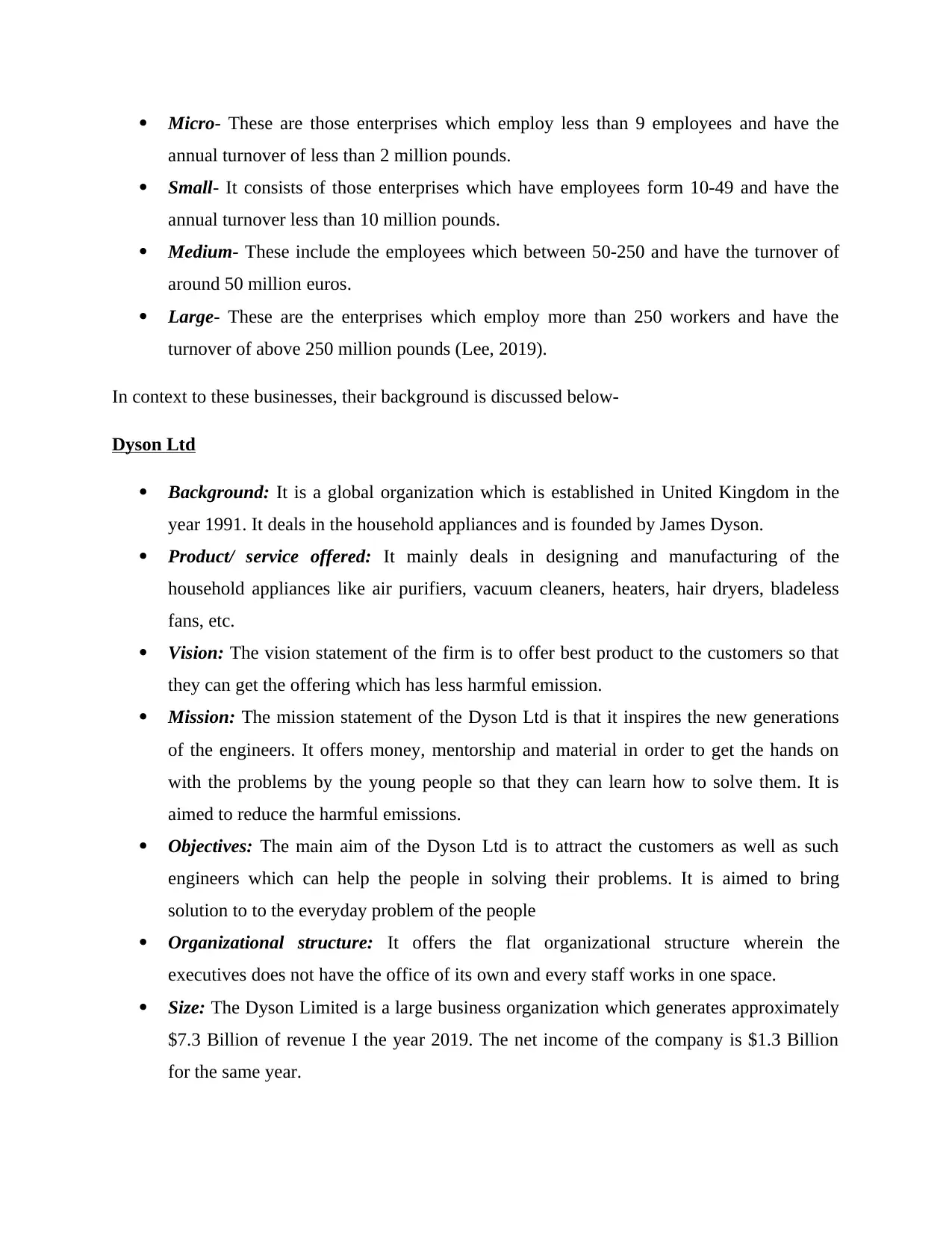
Micro- These are those enterprises which employ less than 9 employees and have the
annual turnover of less than 2 million pounds.
Small- It consists of those enterprises which have employees form 10-49 and have the
annual turnover less than 10 million pounds.
Medium- These include the employees which between 50-250 and have the turnover of
around 50 million euros.
Large- These are the enterprises which employ more than 250 workers and have the
turnover of above 250 million pounds (Lee, 2019).
In context to these businesses, their background is discussed below-
Dyson Ltd
Background: It is a global organization which is established in United Kingdom in the
year 1991. It deals in the household appliances and is founded by James Dyson.
Product/ service offered: It mainly deals in designing and manufacturing of the
household appliances like air purifiers, vacuum cleaners, heaters, hair dryers, bladeless
fans, etc.
Vision: The vision statement of the firm is to offer best product to the customers so that
they can get the offering which has less harmful emission.
Mission: The mission statement of the Dyson Ltd is that it inspires the new generations
of the engineers. It offers money, mentorship and material in order to get the hands on
with the problems by the young people so that they can learn how to solve them. It is
aimed to reduce the harmful emissions.
Objectives: The main aim of the Dyson Ltd is to attract the customers as well as such
engineers which can help the people in solving their problems. It is aimed to bring
solution to to the everyday problem of the people
Organizational structure: It offers the flat organizational structure wherein the
executives does not have the office of its own and every staff works in one space.
Size: The Dyson Limited is a large business organization which generates approximately
$7.3 Billion of revenue I the year 2019. The net income of the company is $1.3 Billion
for the same year.
annual turnover of less than 2 million pounds.
Small- It consists of those enterprises which have employees form 10-49 and have the
annual turnover less than 10 million pounds.
Medium- These include the employees which between 50-250 and have the turnover of
around 50 million euros.
Large- These are the enterprises which employ more than 250 workers and have the
turnover of above 250 million pounds (Lee, 2019).
In context to these businesses, their background is discussed below-
Dyson Ltd
Background: It is a global organization which is established in United Kingdom in the
year 1991. It deals in the household appliances and is founded by James Dyson.
Product/ service offered: It mainly deals in designing and manufacturing of the
household appliances like air purifiers, vacuum cleaners, heaters, hair dryers, bladeless
fans, etc.
Vision: The vision statement of the firm is to offer best product to the customers so that
they can get the offering which has less harmful emission.
Mission: The mission statement of the Dyson Ltd is that it inspires the new generations
of the engineers. It offers money, mentorship and material in order to get the hands on
with the problems by the young people so that they can learn how to solve them. It is
aimed to reduce the harmful emissions.
Objectives: The main aim of the Dyson Ltd is to attract the customers as well as such
engineers which can help the people in solving their problems. It is aimed to bring
solution to to the everyday problem of the people
Organizational structure: It offers the flat organizational structure wherein the
executives does not have the office of its own and every staff works in one space.
Size: The Dyson Limited is a large business organization which generates approximately
$7.3 Billion of revenue I the year 2019. The net income of the company is $1.3 Billion
for the same year.
⊘ This is a preview!⊘
Do you want full access?
Subscribe today to unlock all pages.

Trusted by 1+ million students worldwide

No. of employees: It has around more than 13000 workforces who work for the
achievement of organizational objectives.
Stakeholders: The CEO of the company is Roland Kruegar and the owner and chief
engineer is James Dyson. The chief lighting engineer is Jake Dyson (Krasnov and et.al.,
2017).
British Broadcasting Corporation
Background: It is a national broadcaster of UK which is headquartered at the
Broadcasting House in the London. It is the statutory corporation which has a Royal
Charter. It was founded in the year 1922 by HM Government.
Product/ service offered: BBC serves at the global level and is the world’s oldest
broadcaster at the national level. It deals in the mass media industry and offers news and
latest update to the people via its broadcasting. In product range, it has web portals and
broadcasting and offers services on radio, television and via online.
Vision: Its vision statement provides that the nation must speak the peace unto Nation.
Mission: The mission statement of the company is to act in public interest and serve the
audience by the provision of the impartiality. It provides high quality and the distinct
output which entertains, educate and inform the people.
Objectives: To offer impartial information and news to the people in order to help them
understand and also engage with world that is around them. Its objective is also to
support the learning for the people of every age.
Organizational structure: It follows the hierarchical structure which comprises of the
Board of Governor, creative board, executive board, commercial and Journalism board.
The creative, commercial and journalism board are obliged to report to the executive
board.
Size: The BBC organization is the public owned company which has its operations
divided into division such as BBC studios, BBC Music and BBC sports. It is a large
organization which serves the people with its services worldwide.
No. of employees: BBC comprises of approximately 22,749 employees who serves the
people with their product and service. They altogether puts effort in uplifting its mission.
achievement of organizational objectives.
Stakeholders: The CEO of the company is Roland Kruegar and the owner and chief
engineer is James Dyson. The chief lighting engineer is Jake Dyson (Krasnov and et.al.,
2017).
British Broadcasting Corporation
Background: It is a national broadcaster of UK which is headquartered at the
Broadcasting House in the London. It is the statutory corporation which has a Royal
Charter. It was founded in the year 1922 by HM Government.
Product/ service offered: BBC serves at the global level and is the world’s oldest
broadcaster at the national level. It deals in the mass media industry and offers news and
latest update to the people via its broadcasting. In product range, it has web portals and
broadcasting and offers services on radio, television and via online.
Vision: Its vision statement provides that the nation must speak the peace unto Nation.
Mission: The mission statement of the company is to act in public interest and serve the
audience by the provision of the impartiality. It provides high quality and the distinct
output which entertains, educate and inform the people.
Objectives: To offer impartial information and news to the people in order to help them
understand and also engage with world that is around them. Its objective is also to
support the learning for the people of every age.
Organizational structure: It follows the hierarchical structure which comprises of the
Board of Governor, creative board, executive board, commercial and Journalism board.
The creative, commercial and journalism board are obliged to report to the executive
board.
Size: The BBC organization is the public owned company which has its operations
divided into division such as BBC studios, BBC Music and BBC sports. It is a large
organization which serves the people with its services worldwide.
No. of employees: BBC comprises of approximately 22,749 employees who serves the
people with their product and service. They altogether puts effort in uplifting its mission.
Paraphrase This Document
Need a fresh take? Get an instant paraphrase of this document with our AI Paraphraser
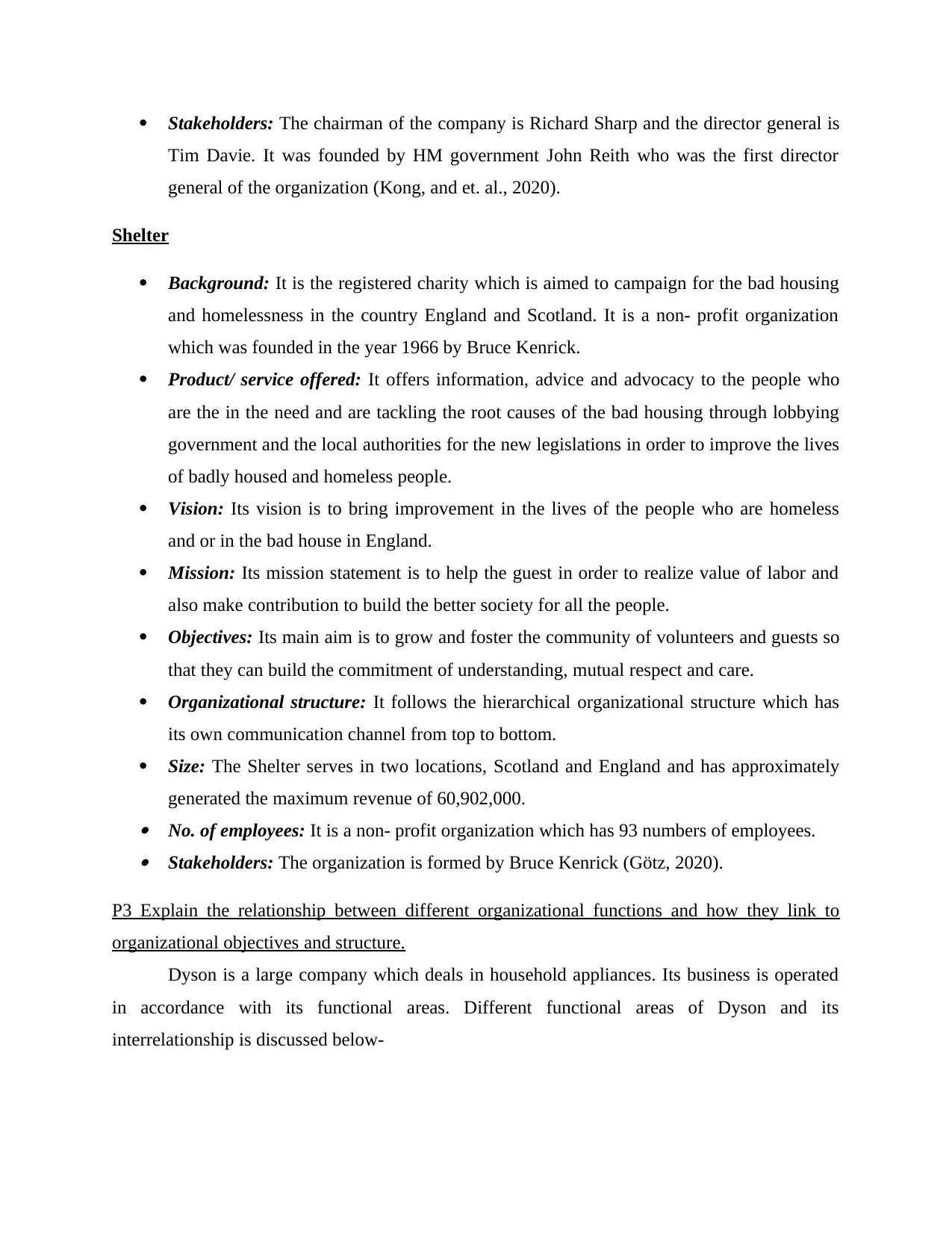
Stakeholders: The chairman of the company is Richard Sharp and the director general is
Tim Davie. It was founded by HM government John Reith who was the first director
general of the organization (Kong, and et. al., 2020).
Shelter
Background: It is the registered charity which is aimed to campaign for the bad housing
and homelessness in the country England and Scotland. It is a non- profit organization
which was founded in the year 1966 by Bruce Kenrick.
Product/ service offered: It offers information, advice and advocacy to the people who
are the in the need and are tackling the root causes of the bad housing through lobbying
government and the local authorities for the new legislations in order to improve the lives
of badly housed and homeless people.
Vision: Its vision is to bring improvement in the lives of the people who are homeless
and or in the bad house in England.
Mission: Its mission statement is to help the guest in order to realize value of labor and
also make contribution to build the better society for all the people.
Objectives: Its main aim is to grow and foster the community of volunteers and guests so
that they can build the commitment of understanding, mutual respect and care.
Organizational structure: It follows the hierarchical organizational structure which has
its own communication channel from top to bottom.
Size: The Shelter serves in two locations, Scotland and England and has approximately
generated the maximum revenue of 60,902,000. No. of employees: It is a non- profit organization which has 93 numbers of employees. Stakeholders: The organization is formed by Bruce Kenrick (Götz, 2020).
P3 Explain the relationship between different organizational functions and how they link to
organizational objectives and structure.
Dyson is a large company which deals in household appliances. Its business is operated
in accordance with its functional areas. Different functional areas of Dyson and its
interrelationship is discussed below-
Tim Davie. It was founded by HM government John Reith who was the first director
general of the organization (Kong, and et. al., 2020).
Shelter
Background: It is the registered charity which is aimed to campaign for the bad housing
and homelessness in the country England and Scotland. It is a non- profit organization
which was founded in the year 1966 by Bruce Kenrick.
Product/ service offered: It offers information, advice and advocacy to the people who
are the in the need and are tackling the root causes of the bad housing through lobbying
government and the local authorities for the new legislations in order to improve the lives
of badly housed and homeless people.
Vision: Its vision is to bring improvement in the lives of the people who are homeless
and or in the bad house in England.
Mission: Its mission statement is to help the guest in order to realize value of labor and
also make contribution to build the better society for all the people.
Objectives: Its main aim is to grow and foster the community of volunteers and guests so
that they can build the commitment of understanding, mutual respect and care.
Organizational structure: It follows the hierarchical organizational structure which has
its own communication channel from top to bottom.
Size: The Shelter serves in two locations, Scotland and England and has approximately
generated the maximum revenue of 60,902,000. No. of employees: It is a non- profit organization which has 93 numbers of employees. Stakeholders: The organization is formed by Bruce Kenrick (Götz, 2020).
P3 Explain the relationship between different organizational functions and how they link to
organizational objectives and structure.
Dyson is a large company which deals in household appliances. Its business is operated
in accordance with its functional areas. Different functional areas of Dyson and its
interrelationship is discussed below-
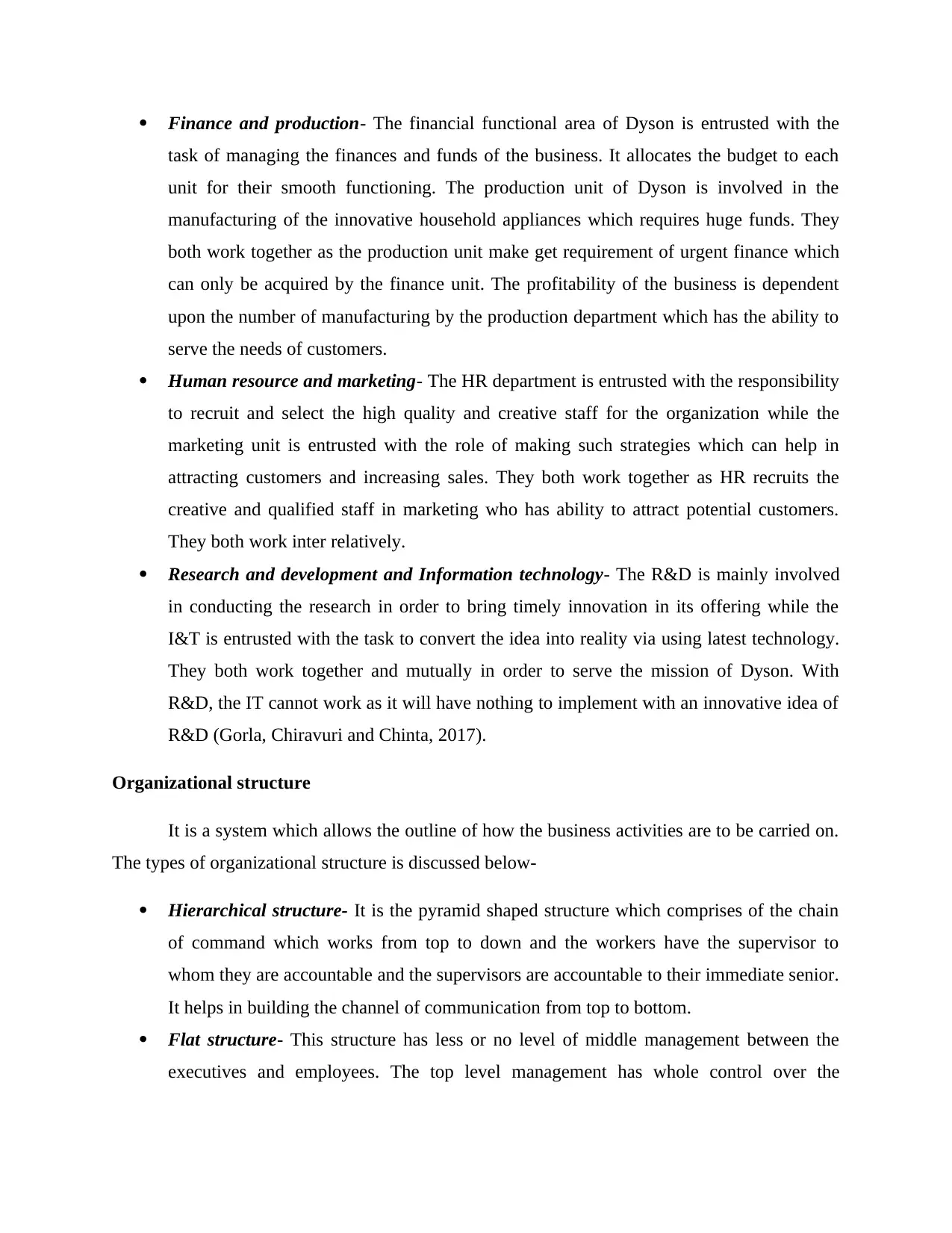
Finance and production- The financial functional area of Dyson is entrusted with the
task of managing the finances and funds of the business. It allocates the budget to each
unit for their smooth functioning. The production unit of Dyson is involved in the
manufacturing of the innovative household appliances which requires huge funds. They
both work together as the production unit make get requirement of urgent finance which
can only be acquired by the finance unit. The profitability of the business is dependent
upon the number of manufacturing by the production department which has the ability to
serve the needs of customers.
Human resource and marketing- The HR department is entrusted with the responsibility
to recruit and select the high quality and creative staff for the organization while the
marketing unit is entrusted with the role of making such strategies which can help in
attracting customers and increasing sales. They both work together as HR recruits the
creative and qualified staff in marketing who has ability to attract potential customers.
They both work inter relatively.
Research and development and Information technology- The R&D is mainly involved
in conducting the research in order to bring timely innovation in its offering while the
I&T is entrusted with the task to convert the idea into reality via using latest technology.
They both work together and mutually in order to serve the mission of Dyson. With
R&D, the IT cannot work as it will have nothing to implement with an innovative idea of
R&D (Gorla, Chiravuri and Chinta, 2017).
Organizational structure
It is a system which allows the outline of how the business activities are to be carried on.
The types of organizational structure is discussed below-
Hierarchical structure- It is the pyramid shaped structure which comprises of the chain
of command which works from top to down and the workers have the supervisor to
whom they are accountable and the supervisors are accountable to their immediate senior.
It helps in building the channel of communication from top to bottom.
Flat structure- This structure has less or no level of middle management between the
executives and employees. The top level management has whole control over the
task of managing the finances and funds of the business. It allocates the budget to each
unit for their smooth functioning. The production unit of Dyson is involved in the
manufacturing of the innovative household appliances which requires huge funds. They
both work together as the production unit make get requirement of urgent finance which
can only be acquired by the finance unit. The profitability of the business is dependent
upon the number of manufacturing by the production department which has the ability to
serve the needs of customers.
Human resource and marketing- The HR department is entrusted with the responsibility
to recruit and select the high quality and creative staff for the organization while the
marketing unit is entrusted with the role of making such strategies which can help in
attracting customers and increasing sales. They both work together as HR recruits the
creative and qualified staff in marketing who has ability to attract potential customers.
They both work inter relatively.
Research and development and Information technology- The R&D is mainly involved
in conducting the research in order to bring timely innovation in its offering while the
I&T is entrusted with the task to convert the idea into reality via using latest technology.
They both work together and mutually in order to serve the mission of Dyson. With
R&D, the IT cannot work as it will have nothing to implement with an innovative idea of
R&D (Gorla, Chiravuri and Chinta, 2017).
Organizational structure
It is a system which allows the outline of how the business activities are to be carried on.
The types of organizational structure is discussed below-
Hierarchical structure- It is the pyramid shaped structure which comprises of the chain
of command which works from top to down and the workers have the supervisor to
whom they are accountable and the supervisors are accountable to their immediate senior.
It helps in building the channel of communication from top to bottom.
Flat structure- This structure has less or no level of middle management between the
executives and employees. The top level management has whole control over the
⊘ This is a preview!⊘
Do you want full access?
Subscribe today to unlock all pages.

Trusted by 1+ million students worldwide
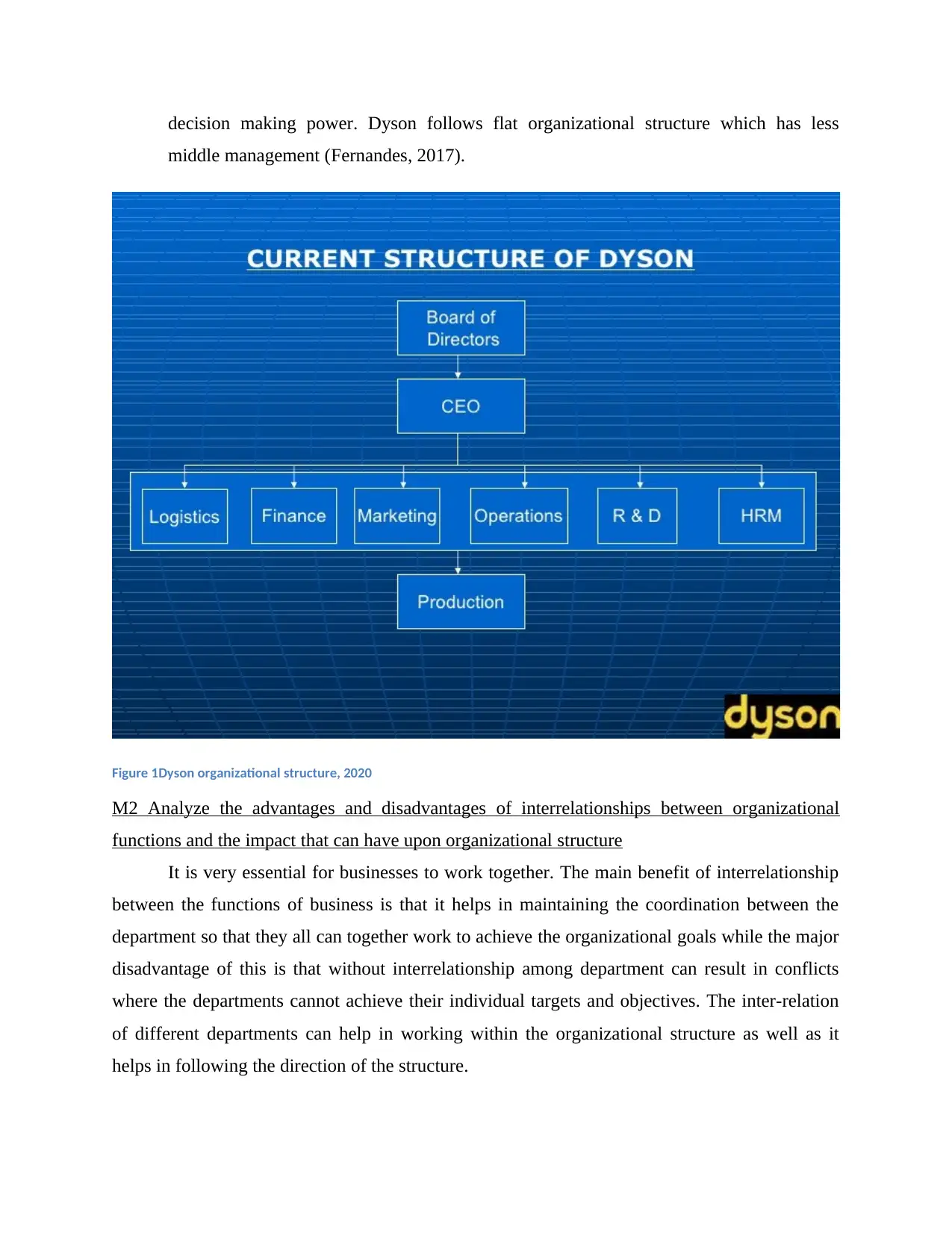
decision making power. Dyson follows flat organizational structure which has less
middle management (Fernandes, 2017).
Figure 1Dyson organizational structure, 2020
M2 Analyze the advantages and disadvantages of interrelationships between organizational
functions and the impact that can have upon organizational structure
It is very essential for businesses to work together. The main benefit of interrelationship
between the functions of business is that it helps in maintaining the coordination between the
department so that they all can together work to achieve the organizational goals while the major
disadvantage of this is that without interrelationship among department can result in conflicts
where the departments cannot achieve their individual targets and objectives. The inter-relation
of different departments can help in working within the organizational structure as well as it
helps in following the direction of the structure.
middle management (Fernandes, 2017).
Figure 1Dyson organizational structure, 2020
M2 Analyze the advantages and disadvantages of interrelationships between organizational
functions and the impact that can have upon organizational structure
It is very essential for businesses to work together. The main benefit of interrelationship
between the functions of business is that it helps in maintaining the coordination between the
department so that they all can together work to achieve the organizational goals while the major
disadvantage of this is that without interrelationship among department can result in conflicts
where the departments cannot achieve their individual targets and objectives. The inter-relation
of different departments can help in working within the organizational structure as well as it
helps in following the direction of the structure.
Paraphrase This Document
Need a fresh take? Get an instant paraphrase of this document with our AI Paraphraser
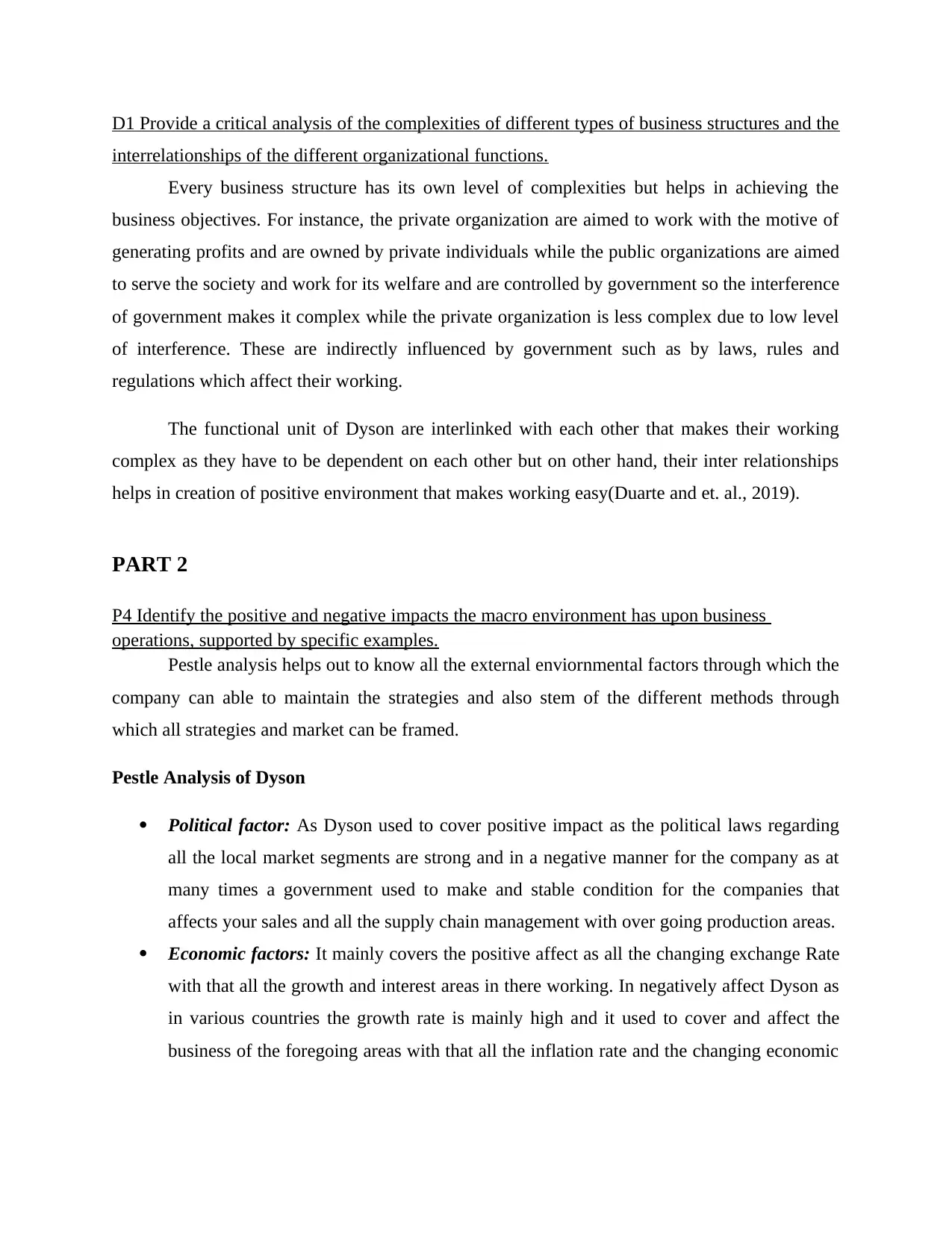
D1 Provide a critical analysis of the complexities of different types of business structures and the
interrelationships of the different organizational functions.
Every business structure has its own level of complexities but helps in achieving the
business objectives. For instance, the private organization are aimed to work with the motive of
generating profits and are owned by private individuals while the public organizations are aimed
to serve the society and work for its welfare and are controlled by government so the interference
of government makes it complex while the private organization is less complex due to low level
of interference. These are indirectly influenced by government such as by laws, rules and
regulations which affect their working.
The functional unit of Dyson are interlinked with each other that makes their working
complex as they have to be dependent on each other but on other hand, their inter relationships
helps in creation of positive environment that makes working easy(Duarte and et. al., 2019).
PART 2
P4 Identify the positive and negative impacts the macro environment has upon business
operations, supported by specific examples.
Pestle analysis helps out to know all the external enviornmental factors through which the
company can able to maintain the strategies and also stem of the different methods through
which all strategies and market can be framed.
Pestle Analysis of Dyson
Political factor: As Dyson used to cover positive impact as the political laws regarding
all the local market segments are strong and in a negative manner for the company as at
many times a government used to make and stable condition for the companies that
affects your sales and all the supply chain management with over going production areas.
Economic factors: It mainly covers the positive affect as all the changing exchange Rate
with that all the growth and interest areas in there working. In negatively affect Dyson as
in various countries the growth rate is mainly high and it used to cover and affect the
business of the foregoing areas with that all the inflation rate and the changing economic
interrelationships of the different organizational functions.
Every business structure has its own level of complexities but helps in achieving the
business objectives. For instance, the private organization are aimed to work with the motive of
generating profits and are owned by private individuals while the public organizations are aimed
to serve the society and work for its welfare and are controlled by government so the interference
of government makes it complex while the private organization is less complex due to low level
of interference. These are indirectly influenced by government such as by laws, rules and
regulations which affect their working.
The functional unit of Dyson are interlinked with each other that makes their working
complex as they have to be dependent on each other but on other hand, their inter relationships
helps in creation of positive environment that makes working easy(Duarte and et. al., 2019).
PART 2
P4 Identify the positive and negative impacts the macro environment has upon business
operations, supported by specific examples.
Pestle analysis helps out to know all the external enviornmental factors through which the
company can able to maintain the strategies and also stem of the different methods through
which all strategies and market can be framed.
Pestle Analysis of Dyson
Political factor: As Dyson used to cover positive impact as the political laws regarding
all the local market segments are strong and in a negative manner for the company as at
many times a government used to make and stable condition for the companies that
affects your sales and all the supply chain management with over going production areas.
Economic factors: It mainly covers the positive affect as all the changing exchange Rate
with that all the growth and interest areas in there working. In negatively affect Dyson as
in various countries the growth rate is mainly high and it used to cover and affect the
business of the foregoing areas with that all the inflation rate and the changing economic
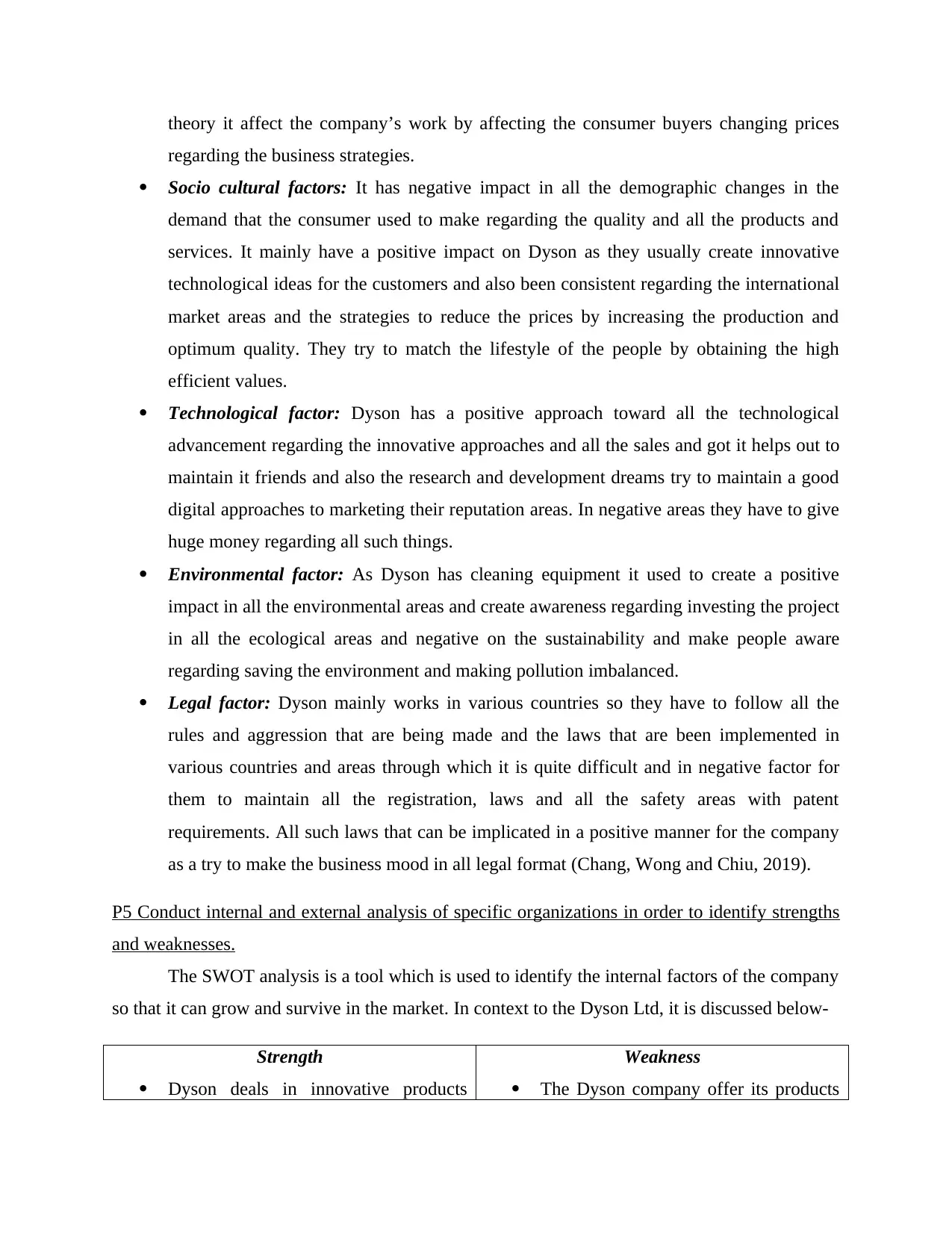
theory it affect the company’s work by affecting the consumer buyers changing prices
regarding the business strategies.
Socio cultural factors: It has negative impact in all the demographic changes in the
demand that the consumer used to make regarding the quality and all the products and
services. It mainly have a positive impact on Dyson as they usually create innovative
technological ideas for the customers and also been consistent regarding the international
market areas and the strategies to reduce the prices by increasing the production and
optimum quality. They try to match the lifestyle of the people by obtaining the high
efficient values.
Technological factor: Dyson has a positive approach toward all the technological
advancement regarding the innovative approaches and all the sales and got it helps out to
maintain it friends and also the research and development dreams try to maintain a good
digital approaches to marketing their reputation areas. In negative areas they have to give
huge money regarding all such things.
Environmental factor: As Dyson has cleaning equipment it used to create a positive
impact in all the environmental areas and create awareness regarding investing the project
in all the ecological areas and negative on the sustainability and make people aware
regarding saving the environment and making pollution imbalanced.
Legal factor: Dyson mainly works in various countries so they have to follow all the
rules and aggression that are being made and the laws that are been implemented in
various countries and areas through which it is quite difficult and in negative factor for
them to maintain all the registration, laws and all the safety areas with patent
requirements. All such laws that can be implicated in a positive manner for the company
as a try to make the business mood in all legal format (Chang, Wong and Chiu, 2019).
P5 Conduct internal and external analysis of specific organizations in order to identify strengths
and weaknesses.
The SWOT analysis is a tool which is used to identify the internal factors of the company
so that it can grow and survive in the market. In context to the Dyson Ltd, it is discussed below-
Strength
Dyson deals in innovative products
Weakness
The Dyson company offer its products
regarding the business strategies.
Socio cultural factors: It has negative impact in all the demographic changes in the
demand that the consumer used to make regarding the quality and all the products and
services. It mainly have a positive impact on Dyson as they usually create innovative
technological ideas for the customers and also been consistent regarding the international
market areas and the strategies to reduce the prices by increasing the production and
optimum quality. They try to match the lifestyle of the people by obtaining the high
efficient values.
Technological factor: Dyson has a positive approach toward all the technological
advancement regarding the innovative approaches and all the sales and got it helps out to
maintain it friends and also the research and development dreams try to maintain a good
digital approaches to marketing their reputation areas. In negative areas they have to give
huge money regarding all such things.
Environmental factor: As Dyson has cleaning equipment it used to create a positive
impact in all the environmental areas and create awareness regarding investing the project
in all the ecological areas and negative on the sustainability and make people aware
regarding saving the environment and making pollution imbalanced.
Legal factor: Dyson mainly works in various countries so they have to follow all the
rules and aggression that are being made and the laws that are been implemented in
various countries and areas through which it is quite difficult and in negative factor for
them to maintain all the registration, laws and all the safety areas with patent
requirements. All such laws that can be implicated in a positive manner for the company
as a try to make the business mood in all legal format (Chang, Wong and Chiu, 2019).
P5 Conduct internal and external analysis of specific organizations in order to identify strengths
and weaknesses.
The SWOT analysis is a tool which is used to identify the internal factors of the company
so that it can grow and survive in the market. In context to the Dyson Ltd, it is discussed below-
Strength
Dyson deals in innovative products
Weakness
The Dyson company offer its products
⊘ This is a preview!⊘
Do you want full access?
Subscribe today to unlock all pages.

Trusted by 1+ million students worldwide
1 out of 19
Related Documents
Your All-in-One AI-Powered Toolkit for Academic Success.
+13062052269
info@desklib.com
Available 24*7 on WhatsApp / Email
![[object Object]](/_next/static/media/star-bottom.7253800d.svg)
Unlock your academic potential
Copyright © 2020–2025 A2Z Services. All Rights Reserved. Developed and managed by ZUCOL.





